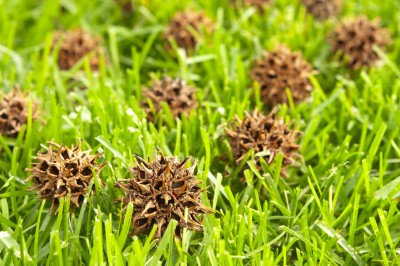






Can you put sweetgum balls in compost? No, I am not talking about the sweet gumballs that we blow bubbles with. In fact, sweetgum balls are anything but sweet. They are an extremely prickly fruit– inedible by the way. Most people want to know how to get rid of the tree from which they come, how to prevent it from fruiting, or if you can compost sweetgum balls. Anything, just get rid of the darn things! Read on for information about composting gumballs.
As previously mentioned, sweetgum balls are the fruit of a medium to large size tree (65-155 feet tall) with a trunk up to 6 feet across that can live for an extremely long time — up to 400 years. The sweetgum tree (Liquidambar styraciflua) produces an extremely spiked capsule containing one or two seeds in the summer. The resulting dropped fruits become woody and are the bane of any wanderer, as they will pierce tender flesh.
The tree prefers moist bottomland and plenty of sun and, as such, is found from southern New England to Florida and west into the nation’s interior states.
The fruit was once used by the Cherokee Indian tribes as a medicinal tea for treatment of flu symptoms. Today, the active ingredient of the infertile sweetgum seeds, which contain high amounts of shikimic acid, is used in the preparation of Tamiflu, but other than that is more of a bane in the landscape.
As to putting sweetgum in compost, there doesn’t seem to be any general consensus. If you are a purist and believe that you should attempt to compost everything, then the best bet is to run a “hot” compost pile. If you run a cool pile, sweetgum in compost will likely not break down and very possibly you will end up with volunteers sprouting from the pile.
The woody fruit, from all accounts, will require a hot compost pile with an internal temperature of over 100 degree F. (37 C.) You will need to maintain the pile, turning the compost and watering it religiously. Keep the compost pile hot and bring your patience. Sweetgum balls will take some time to break down.
Composting gumballs may not result in the most attractive mulch, but the resulting compost is useful as a barrier against rabbits, slugs and other pests. The rough compost will be unpleasant to the undersides or feet of these animals and may deter them from romping through the garden.
Learn About What You Can Do For Driveway Paving
Can You Compost Bird Feathers: How To Compost Feathers Safely
Can You Compost Onions: How To Compost Onion Peelings
Learn More About Using Ashes In Compost
Can You Compost Bird Feathers: How To Compost Feathers Safely
Composting - it can save you money!
Why Should You Learn How To Compost?
What Can You Compost And What Not To Put In Garden Compost
Composting Potato Haulms: Can You Add Potato Tops To Compost
What Can You Compost And What Not To Put In Garden Compost
Composting Potato Haulms: Can You Add Potato Tops To Compost
Copyright © www.100flowers.win Botanic Garden All Rights Reserved